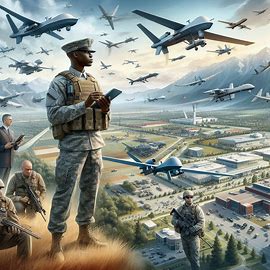
Introduction
The emergence of unmanned aerial vehicles (UAVs), commonly known as drones, has revolutionized the landscape of modern warfare. From intelligence gathering to targeted strikes, drones offer unprecedented capabilities that are reshaping military doctrines and redefining air superiority. This article explores the multiple dimensions of how drones are changing aerial warfare, highlighting technologies, strategies, applications, and future directions.
1. The Evolution of Drones in Warfare
1.1 Historical Overview of Military Drone Use
While drones may seem like a 21st-century phenomenon, their origins in warfare trace back to World War I with rudimentary pilotless aircraft. However, true operational deployment began in earnest during the Cold War.
- Vietnam War: Early reconnaissance drones like the Firebee
- 1990s Gulf War: Surveillance drones gained traction
- Post-9/11 Era: Armed drones like the MQ-1 Predator began precision strikes
These developments paved the way for today’s widespread military UAV adoption.
1.2 Technological Milestones and Miniaturization
Advances in miniaturization, communication, and automation have enabled a broad range of UAVs—from handheld quadcopters to high-altitude, long-endurance drones.
- Materials: Lighter composites and stealth coatings
- Power systems: Efficient batteries and solar options
- AI & Autonomy: Navigation, object recognition, swarm control
This technological boom has drastically reduced human risk while enhancing reach and precision.
2. Strategic Advantages of Drones in Combat
2.1 Enhanced Reconnaissance and Surveillance
Drones are invaluable for ISR (Intelligence, Surveillance, and Reconnaissance) missions, offering real-time visuals of enemy movement without risking personnel.
Benefits:
- Persistent surveillance over conflict zones
- High-resolution imagery and thermal scanning
- Live streaming to command centers
Systems like the RQ-4 Global Hawk can monitor vast areas with minimal risk, enabling proactive decision-making.
2.2 Precision-Strike Capabilities
Armed drones carry laser-guided munitions and can engage targets with surgical accuracy, often with less collateral damage.
Use Cases:
- Elimination of high-value targets
- Close air support in remote areas
- Nighttime or all-weather operations
The MQ-9 Reaper has been central in precision strikes against terrorist cells, revolutionizing counterinsurgency tactics.
2.3 Force Multiplication and Risk Reduction
UAVs extend the operational reach of manned systems, providing valuable force multiplication.
Strategic Roles:
- Escort roles in high-risk zones
- Decoys to mislead enemy defenses
- Unmanned combat air vehicles (UCAVs) supporting piloted fighters
Countries like the U.S. and Israel have integrated drones deeply into joint strike operations to limit human exposure.
3. Types and Roles of Military Drones
3.1 Tactical Drones
These small, portable drones support frontline troops by offering on-demand situational awareness.
Features:
- Hand-launched or backpack-compatible
- Short-range (up to 10 km)
- Real-time video feed
Examples include the RQ-11 Raven, which provides critical data in real-time for tactical units on the move.
3.2 MALE and HALE Drones
Medium-Altitude Long-Endurance (MALE) and High-Altitude Long-Endurance (HALE) drones dominate airspace for extended periods.
| Type | Altitude | Endurance | Example |
|---|---|---|---|
| MALE | 10,000–30,000 ft | 24–48 hrs | MQ-9 Reaper |
| HALE | 50,000–70,000 ft | 30+ hrs | RQ-4 Global Hawk |
These systems play central roles in surveillance and strike coordination.
3.3 Loitering Munitions and Kamikaze Drones
Also known as “suicide drones,” these systems combine the features of UAVs and missiles.
Capabilities:
- Linger until a target is identified
- Deliver explosive payloads with precision
Notable examples include the Israeli Harop and Iran’s Shahed-136, which have seen widespread deployment in recent conflicts.
4. Drone Warfare in Global Conflicts
4.1 Middle Eastern Theaters
Drones have played critical roles in conflicts across Syria, Iraq, and Yemen.
- U.S. & Allied Forces: Used drones for counterterrorism
- Non-State Actors: Acquired commercial drones for improvised attacks
- Iran: Developed and exported drone technology regionally
This has led to asymmetric warfare where even small groups can conduct aerial assaults.
4.2 Ukraine-Russia Conflict
The Russia-Ukraine war has showcased a new era of drone warfare.
Key Observations:
- Use of Turkish Bayraktar TB2 for Ukrainian strikes
- Russian reliance on surveillance drones and kamikaze UAVs
- Massive drone attrition shaping frontline strategies
The conflict has demonstrated how even mid-tier nations can harness drones for large-scale operations.
4.3 Asia-Pacific and Beyond
China, India, and the U.S. are investing heavily in drone tech to assert dominance in the Indo-Pacific.
- China: Expanding military UAVs like the Wing Loong and CH-series
- India: Indigenizing drone programs for border surveillance
- Australia & Japan: Collaborating with allies on UCAV tech
These developments indicate growing drone reliance in power projection and deterrence.
5. Challenges and Future Directions
5.1 Counter-Drone Technologies
As drones proliferate, so do the technologies designed to neutralize them.
Anti-drone Methods:
- Jamming and signal disruption
- Laser weapons
- Net-based or kinetic interceptors
Examples like Israel’s Iron Beam and the U.S. Army’s Directed Energy Maneuver-Short Range Air Defense (DE M-SHORAD) show future battlefield trends.
5.2 Legal and Ethical Implications
Drone strikes have sparked debates over legality and accountability.
Concerns:
- Civilian casualties and targeted killings
- Sovereignty violations
- Autonomous decision-making
The international community continues to grapple with setting boundaries and regulations for drone warfare.
5.3 AI and Swarm Technology
Artificial intelligence is enabling drones to operate in autonomous or semi-autonomous swarms.
Swarm Benefits:
- Overwhelm defenses with volume
- Self-organizing tactics
- Redundant architecture for mission success
Research by DARPA and Chinese military labs suggests future air battles may be dominated by swarms of intelligent drones.
Conclusion: The Drone Revolution in the Sky
Drones have undeniably changed the rules of engagement in aerial warfare. Their ability to provide real-time intelligence, carry out lethal precision strikes, and execute missions without endangering pilots has redefined strategic calculus.
However, with opportunity comes responsibility. As drones become smarter, faster, and deadlier, the need for comprehensive international regulations and ethical frameworks becomes even more pressing.